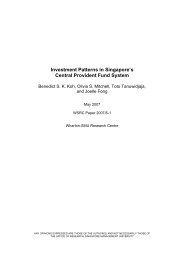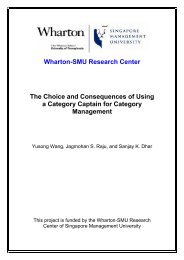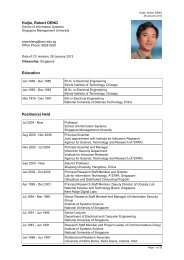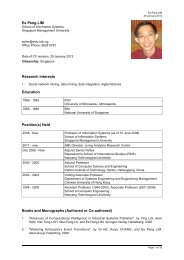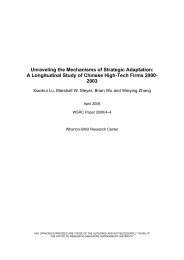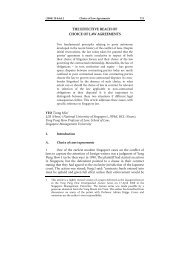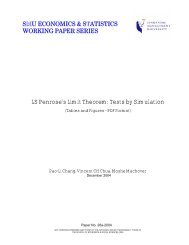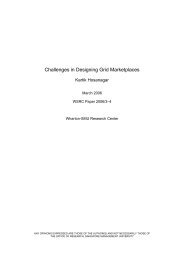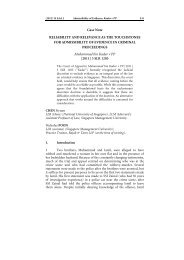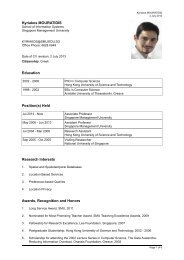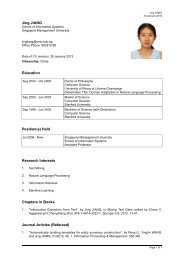The Benefits of Volume-Conditional Order-Crossing - Singapore ...
The Benefits of Volume-Conditional Order-Crossing - Singapore ...
The Benefits of Volume-Conditional Order-Crossing - Singapore ...
Create successful ePaper yourself
Turn your PDF publications into a flip-book with our unique Google optimized e-Paper software.
Pro<strong>of</strong> <strong>of</strong> Proposition 4.1<br />
If an informed trader chooses to trade in the continuous market after observing ˜s = +1, his<br />
expected pr<strong>of</strong>its are equal to E ˜πi | ˜s = +1 = p − a. Since traders always have the option not<br />
to trade, informed traders trade if and only if their common precision p is greater than a. Let<br />
us first assume that p < 2κ<br />
λ<br />
2κ<br />
. <strong>The</strong>n the equilibrium <strong>of</strong> Proposition 2.1, with a = λ , still holds.<br />
Indeed, because a > p, the informed traders choose not to trade in this market. We also know from<br />
Proposition 2.1 that the market-maker can recoup his fixed costs <strong>of</strong> κ by quoting this ask price.<br />
Since lowering his ask price can only reduce the market-maker’s pr<strong>of</strong>its (through lower revenues<br />
and potentially more adverse selection if a dips below p), this is the lowest possible a that has him<br />
break even.<br />
If instead p > 2κ<br />
λ<br />
2κ<br />
, the equilibrium ask price cannot be a = λ , as the market-maker breaks even<br />
on his trades with impatient hedgers but, since p is then larger than a, he loses p − a to each <strong>of</strong><br />
the n informed traders who now find it pr<strong>of</strong>itable to trade on their information. <strong>The</strong> market-maker<br />
must therefore set a to a value greater than 2κ<br />
λ and his expected pr<strong>of</strong>its are then<br />
E aλ<br />
˜π MM = − (p − a)n − κ.<br />
2<br />
(A.6)<br />
In equilibrium, the market-maker breaks even and so a must make this last quantity equal to zero.<br />
This yields (11). Of course, the conjectured equilibrium only holds if the informed traders and<br />
impatient hedgers choose to trade, that is, if a ≤ p and a ≤ r H with the value <strong>of</strong> a just derived.<br />
Straightforward manipulations show that the first <strong>of</strong> these two inequalities is equivalent to p > 2κ<br />
λ ,<br />
which is true in this second part <strong>of</strong> the proposition. <strong>The</strong> second inequality reduces to (10). When<br />
it does not hold, the ask price required to break even no longer attracts the impatient traders and<br />
so no ask price in [0, 1] can produce an equilibrium.<br />
Pro<strong>of</strong> <strong>of</strong> Lemma 4.1<br />
Let us first consider the second part <strong>of</strong> the result, that is, suppose that in equilibrium the<br />
patient hedgers and informed traders place orders in the conditional market. As mentioned in the<br />
paragraph preceding this lemma, a patient trader is better <strong>of</strong>f when the market clears as long as<br />
(13) is greater than −r L for all ˜m = m that trigger market-clearing. It is easy to show that this<br />
condition is equivalent to φ > p−(rL−c)<br />
p+(rL−c)<br />
reduces to<br />
or, equivalently, to<br />
which, after replacing φ by m(1−λ)<br />
m(1−λ)+2n<br />
m > n p − (r L − c) <br />
(1 − λ)(r L − c)<br />
m(1 − λ)<br />
2<br />
> np − (rL − c) <br />
.<br />
2(rL − c)<br />
28<br />
as defined in (12),



